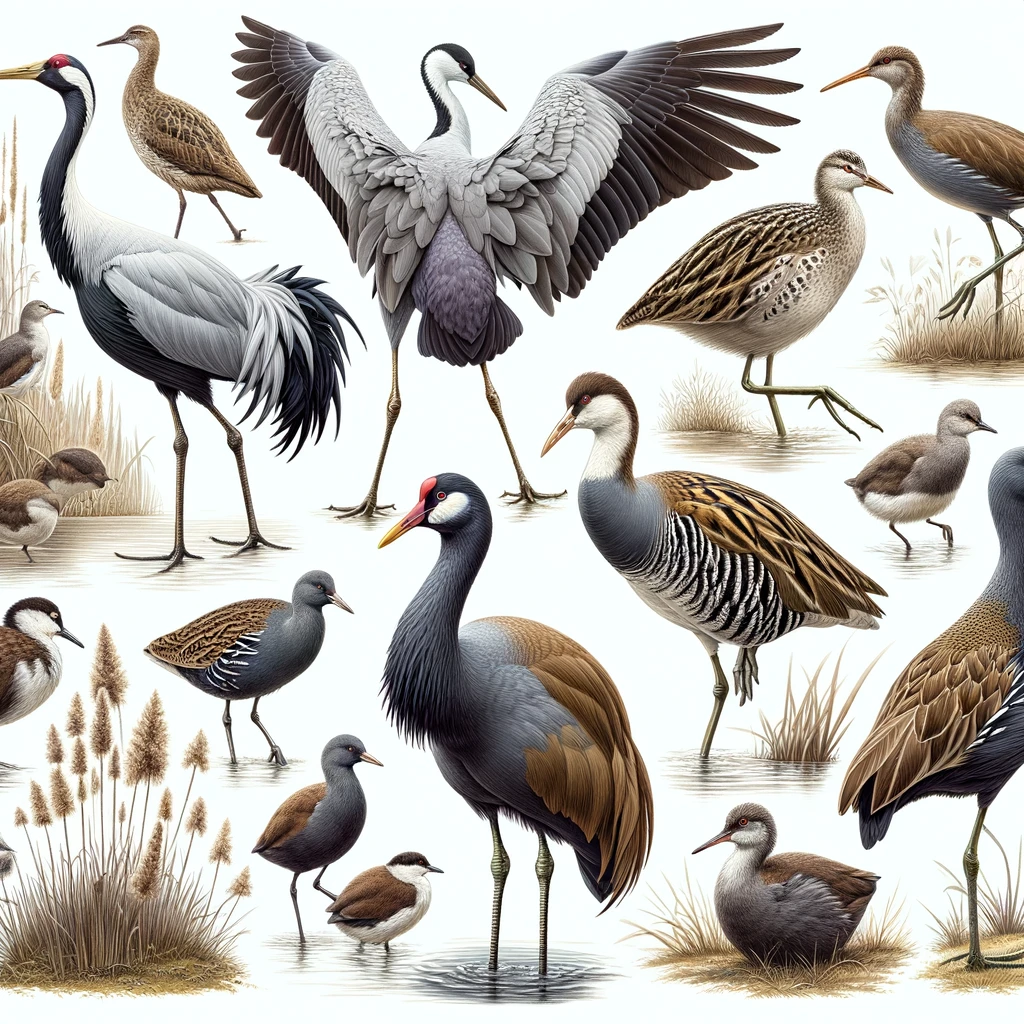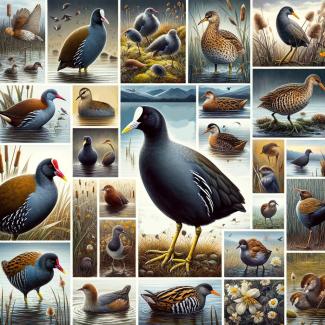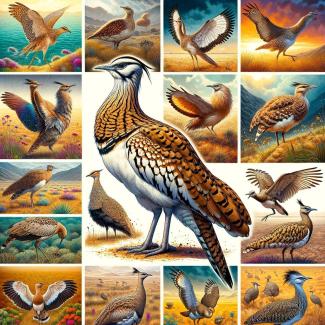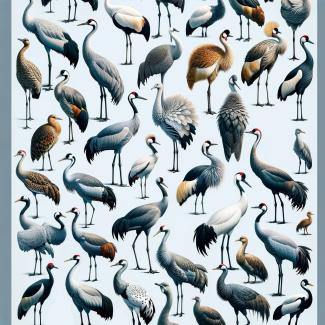
Spanning crakes, rails, gallinules, limpkins, cranes, seriemas, and other marsh-dwelling birds, Gruiformes represents an ecologically diverse order of wading, swimming and terrestrial species most closely tied by ancestral aquatic affinities. With over 200 species across 11 extant families, they maintain nearly global distribution through tropical to temperate regions worldwide.
Gruiformes likely emerged out of common Eocene era ancestors shared with Charadriformes some 50 million years ago as ancestral aquatic forms diverged towards more sustained marsh wading preferences and elaborated vocal repertoires than shorebird relatives over successive splits. Today's lineages showcase shared traits like elongated toes adapted for grasping wetland vegetation during feeding forays.
Contemporary diversity encompasses diminutive 15 centimeter black rails to towering 1.5 meter sarus cranes. Niche separation concentrates nimble rails towards dense reed colonies while giant coots and skilletbirds filter floating vegetation across quiet lowland backwaters from South America through to Australia.
Abundant aquatic food chains facilitate Gruiformes as sentinels for assessing ecosystem health through their numbers revealed foraging across vulnerable wetlands worldwide every dawn. Thereby they function as ubiquitous marsh residents steadfastly upholding balanced inland waterway communities.
Characteristics
Physical Features
Gruiformes display a broad size range - from tiny 20-centimeter black rails to towering 1.5-meter Sarus cranes. Frame size tends to correlate with preferred habitat niches with smaller rails probing dense vegetation close to waterline cover and larger relatives like trumpeters foraging more actively across open shoals.
A shared wide body plan allows high volumetric intake while a lifted head and neck carriage maintains vigilance. Plumage adaptations show both flashy patches in open water forms and barred camouflage streaking concealing secretive skulkers. Bright skin or ceremonial air sack displays often contrast with more subdued feathering across mature breeding adults.
However, the most defining gruiform features remain enlarged feet with extra long front toes supporting the distribution of weight loads across yielding surfaces from marshy peat to floating algal mats.
Strong legs also aid brief bursts running across water surfaces when escaping surprise threats within sedge cover where their compressed profile excels slipping through reeds towards cover. Thereby versatile feet facilitate access across marginal watery terrains.
Behavioral Traits
Primarily omnivorous but skewing more carnivorous, Gruiformes consume a variety of aquatic invertebrates, insects, fish, amphibians, reptiles, small mammals, and some plant material foraged across wetland habitats. Versatile bills facilitate probing substrates, sieving water columns, grasping struggling prey, and tearing vegetation.
Monogamous breeding pairs engage in elaborate synchronized displays on traditional lowland leks or solitary montane meadows to cement seasonal pair bonds. Complex communal nests constructed amidst wetlands often integrate surrounding vegetation to anchor over water or spongy soils.
Reproduction and Lifespan
Single clutch egg sets range from 2 to 10 depending upon species. Both parents incubate and guard precocial young who soon display innate feeding behaviors while still sheltered by watching adults. Time to independence spans 6-10 weeks on average. Estimated lifespan averages 10 to 15 years but large-bodied cranes likely occasionally survive over 20 years.
Some Extant Families
Rallidae (rails, gallinules, coots)
The expansive Rallidae family encompasses small marsh birds like rails, and gallinules, as well as singular coots and endangered flightless takahes now restricted solely to New Zealand. Most smaller members favor densely vegetated wetlands worldwide where escape cover remains nearby.
Gruidae (cranes)
The 15 species of cranes stand out as Gruiformes giants adapted to more open wetlands and drier grasslands. With some species breeding exclusively in isolated pairs and others gathering in vast migratory flocks, cranes remain both conspicuous and conservation flagship species for many regions.
Heliornithidae (finfoots)
The three extant finfoot species occupy remote tropical stream habitats in Central/South America, Africa, and Southeast Asia. Specialized adaptations for swimming and diving in fast-flowing rivers differentiate them from other Gruiformes tied to slower inland waters.
Shared preferences for wetland habitats unite Gruiformes but foothold niches partition resources ranging from secretive swamp browsers to open water waders probing shorelines thereby minimizing competition in these abundant yet delicate ecosystems around the world.
Global Distribution and Habitat
With over 200 species contained across numerous families, Gruiformes enjoys extensive contemporary distribution across all continents except Antarctica thanks chiefly to resilient generalized ecology tolerant of periodic droughts or seasonal climate shifts that may strongly impact more delicate obligate aquatic species.
However, peaks in species diversity concentrate disproportionately across extensive lowland wetlands, floodplains, estuarine marshes, and other shallowly inundated zones prone to high subsurface productivity capable of sustaining the dietary needs of varied Gruiformes year-round.
There water levels may fluctuate dramatically between deluges and sparse remnants allowing Gruidae giants to shift from open pools towards rain-sheltering forest fringes before returning to the same sites when precipitation restores primordial extents.
Thereby gruiforms remain anchored to ancestral waterway adjacencies even as some lineages like trumpeters or seriemas adapted towards drier habitats through dietary expansion beyond core aquatic food chains.
But by retaining innate mechanisms allowing persistence across extreme conditions periodically, Gruiformes dispersals could traverse harsh mountains and arid zones before reaching opposite continental shores over successive generations thanks to immense resilience now apparent across their constituent families worldwide.
Ecological Importance
As abundant wetland residents adept at exploiting both open waterways and dense vegetation across marshy peripheries, Gruiformes provide valuable ecosystem services maintaining habitat integrity. Constant foraging activities help check invasive weeds that might otherwise choke shallow lakes while pruning beneficial native aquatic plants that require routine cutting stimulation to maintain vigorous growth.
Seed dispersal also assists some species through incidental gut passage events and attachment externally to feathers. Thereby gruiforms enhance propagule distribution patterns for many plants relying upon mobile biotic vectors to spread reproductive cells beyond standard hydrochorous dispersal range limits.
Gruiformes additionally serve as sensitive indicators for assessing ecosystem health through their numbers revealed foraging across sensitive habitats prone to bioaccumulation of pesticides, heavy metal contamination, and siltation threats. As predominantly wetland birds, population stability reflects suitable food availability and water quality conditions.
Many species also concentrate incredible biomass during migration or winter congregation events - funneling and circulating nutrients between dispersed summer breeding locales and more confined wintering habitats. Thereby they integrate global habitat connectively sustaining biodiversity across isolated sites.
Gruiformes in Nepal
Nepal’s extensive wetlands and grasslands spanning lowland Terai plains to high Himalayan meadows sustain impressive Gruiformes diversity - with around 30 species confirmed within the country. Foothill streams shelter secretive white-breasted and black-tailed crakes within fringing aquatic vegetation. While the endangered sarus crane ornaments many village wetlands across the central lowlands.
The remote high passes decorate each summer with the arrival of specialized shorebirds like the Tibetan sandgrouse and Pallas’s sandgrouse undertaking lengthy migrations up from Indian wintering grounds through the Himalayas. While both resident and visiting rails, gallinules, lapwings, and finfoots all contribute year-round.
While many species remain common, the degradation of wetland areas to agricultural plots without conservation buffers threatens essential habitat. Groups like the Zoological Society of London aid campaigns for increased protection - identifying key sites and promoting expansion efforts to preserve vital staging grounds sustaining migratory populations along the Central Asian Flyway reaching down towards Nepal during seasonal movements.
Beyond ecology, vibrant dancing displays of breeding sarus cranes mesmerize local communities - featuring prominently in indigenous Tharu cultural dress and ornamentation as symbols of divine blessing, fertility and good fortune. Thereby local efforts help align migratory bird preservation aims.
Conservation Challenges and Efforts
While many species remain locally abundant, increasing pressures have pushed over a quarter of Gruiformes onto threatened or near threatened conservation status - including endangered crowned cranes and white-winged flufftails losing wetland strongholds across Subsaharan Africa. Beyond outright habitat destruction, subtle drying triggers and precipitation changes induced by climate shifts have deteriorated reserves.
As wetland obligates, habitat loss poses the most severe looming crisis facing Gruiformes persistence long term. Drainage for flood control or agricultural reclamation eliminates essential foraging, nesting, and migratory stopover refuge areas outright. Pollution accumulating from adjacent industrial or residential zones also degrades suitability through direct mortality and prey contamination impacts.
However, concerted conservation initiatives gain momentum to reverse deterioration trends before additional species decline using integrated site-specific interventions.
These encompass legislation campaigns bringing protection status for deteriorating habitats, working with local communities towards sustainable harvesting/hunting allowances, captive breeding reintroduction programming to restore declining endemic species, and seasonal anti-poaching patrols to limit threats around critically endangered species sites across the world.
While considerable work remains, flagship attention towards saving charismatic giant Gruidae species promises associated stability radiating towards smaller vulnerable neighbors sharing vulnerable wetland ecosystems across drying climates. Thereby they sustain biodiverse refugia through uncertainty ahead.
Conclusion
Gruiformes varied lineages tracing back to common Cenozoic stock showcase remarkable evolutionary diversification from tiny cryptic rails to colossal cranes - hinting at immense adaptive potential still left uncertain across surviving species in this order. As predominant yet unassuming marsh residents, their stable populations uphold wetland functionality through intricate connections still being revealed.
Moving forward amidst climate shifts predicted to deteriorate vulnerable waterway ecosystems prone to increasing aridity and saltwater intrusion threats along coasts worldwide, prioritizing habitat protections becomes paramount for perpetuating Gruiformes refugia in coming decades.
Integrated site management through local community partnerships provides essential knowledge resources to sustain balanced zones benefiting both people and wildlife through extremes in either direction.
In Nepal, maintaining productivity across the complex river deltas and high wetland breeding sites decorating the country remains imperative both for sustaining essential Eastern migratory bird flyway connectivity as well as preserving regional food/water security fundamentally tied to the fate of seasonal Himalayan glacier flows where Gruiformes sentinels stand vigil testing the winds to see what tomorrow may bring downstream.



